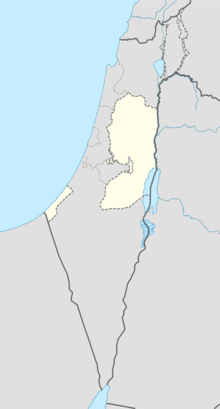 Nabi Samwil mosque built on remains of Crusader-era fortress; the Tomb of Samuel is in a crypt below the Mamluk building. | |
| Coordinates | 31°49′59″N 35°10′54″E / 31.832978°N 35.181633°E |
|---|---|

The Tomb of Samuel (Arabic: النبي صموئيل, translit. an-Nabi Samu'il or Nebi Samwil, Hebrew: קבר שמואל הנביא, translit. Kever Shmuel ha-Navi), commonly known as Nebi Samuel or Nebi Samwil, is the traditional burial site of the biblical prophet Samuel, atop a steep hill at an elevation of 908 m (2,979 ft) above sea level, in the Palestinian village of Nabi Samwil, in the West Bank.[1]
The site is of both religious and archaeological interest. In the 6th century, a monastery was built at the site in honor of Samuel, and during the early Arab period the place was known as Dir Samwil (the Samuel Monastery).[2] In the 12th century, during the Crusader period, a fortress was built on the area.[2]
The present structure is a mosque from the 14th century, built during the Mamluk period.[2] The purported tomb itself is in an underground chamber which has been repurposed after 1967 as a synagogue, today with separate prayer areas for Jewish men and women.
Since the beginning of the Israeli occupation of the West Bank after the Six-Day War, the site is managed by the Israel Nature and Parks Authority.
- ^ "Hanukkah menorah removed from roof of mosque after Palestinians protest". www.timesofisrael.com. 25 November 2021. Retrieved 29 July 2022.
- ^ a b c "Nebi Samuel Park – Israel Nature and Parks Authority". en.parks.org.il. Archived from the original on 2022-03-12. Retrieved 2022-06-03.
